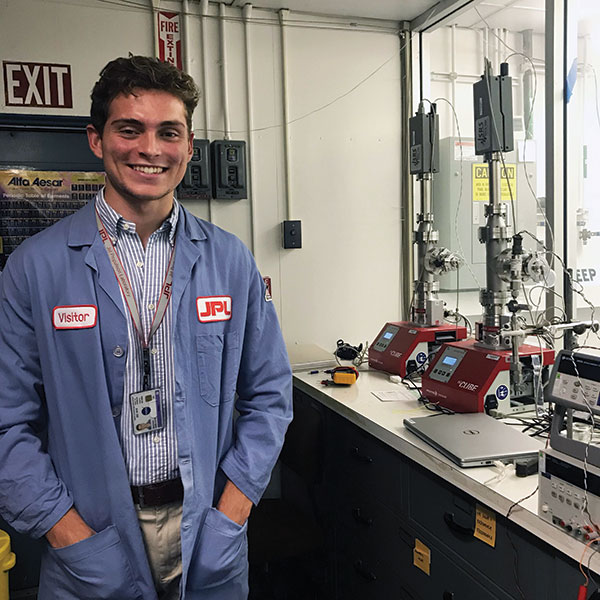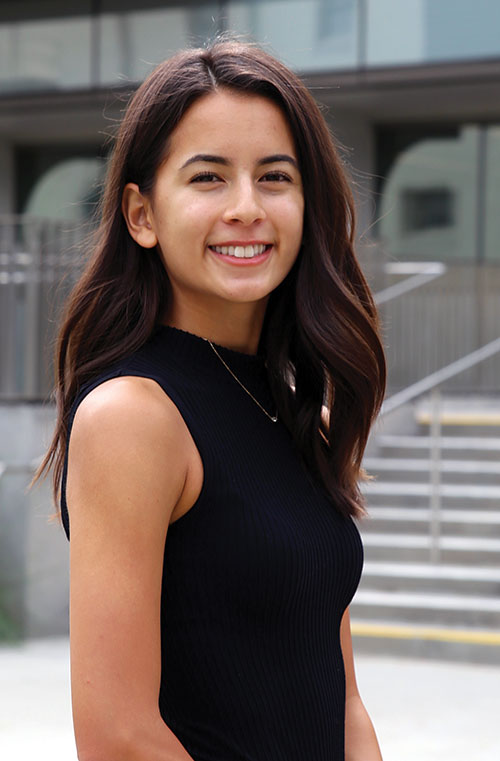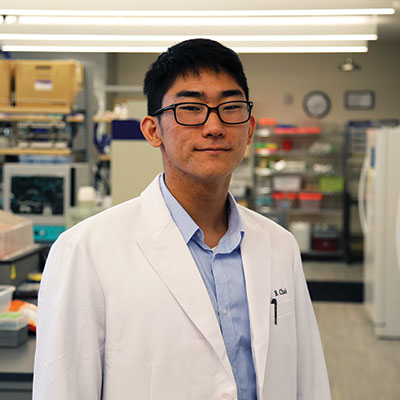The transparent walls of the Science & Learning Center provide a window to the scientific activity that happens on campus every day. What is also on display—but perhaps harder to visually identify—is the incredible amount of mentorship and collaboration happening between faculty and students. Professors work with students to create research projects, allowing them to hone their skills and develop their interest in various subjects. Going the extra mile, faculty members also guide students in the process of securing College fellowships and off-campus research opportunities known as Research Experiences for Undergraduates (REUs).
With the support of this type of mentorship, the following students have taken their scientific passions to the next level.
 Breathing on Mars
Breathing on Mars
Gianluca Bencomo ’21 is going to help save the world and put humankind on Mars. That’s an exaggeration, but it’s kind of not. Bencomo recently finished research at NASA’s nearby Jet Propulsion Lab (JPL) on efficiently turning carbon dioxide into oxygen and water. That’s not only crucial to NASA’s mission to put astronauts on Mars by 2035; it’s a potential life-saver here on Earth, where carbon emissions have pushed the atmosphere past its healthy limits.
Before the first human being can take one giant leap on the red planet, NASA needs to know that the crew will have enough air to stay on the planet for 18 months and get home— a process which includes rocketing off the surface. Rocket fuel requires a ton of oxygen, a chemical element Mars is sadly lacking, with an atmosphere that is almost entirely carbon dioxide.
Bencomo tested one option for turning the gas into breathable air, as well as methane, which the rocket fuel also needs. The basic idea is to use acid, hydrogen ions, and an electric charge to break down carbon dioxide into water and carbon monoxide, then split the water into oxygen. The equation was missing a catalyst and a way to break down the carbon dioxide, and that’s where Bencomo’s experiments came in.
By the end, there were some days when Bencomo was arriving at the laboratory before 8 a.m. and running experiments for 12, 13 hours. Silver nanoparticles seemed like a good option for breaking down carbon dioxide, but the tests weren’t giving them the results they wanted, and Bencomo’s 10-week internship was coming to a close.
It was another frustrating marathon of experiments at the lab, and the day before Bencomo’s final presentation, when it finally worked.
He understands his contribution is a small part of an enormous undertaking, involving hundreds of people. NASA may ultimately choose another method for bringing water and oxygen to Mars. But Bencomo knows that this method matters to Earth, too, where roughly 3,200 gigatons of carbon dioxide are floating in the atmosphere. A safe level is about 2,800.
“This CO2 conversion method could potentially be used to take CO2 out of the atmosphere and kind of clean up the air,” he said.
Meanwhile, on campus, Bencomo is turning his sights to another toxin: organophosphate pesticides, a common pest control in the fields and orchards of California’s Central Valley, and beyond. The same summer as his work with JPL, he began research with professor Erica Fradinger, the James Irvine Foundation Chair in Biological Sciences, to understand how one of the pesticides might be affecting people’s brains. The pesticides influence neuronal development and could have a role in the development of neurodegenerative disease.
The experiments aren’t easy. Bencomo has to find a way to image neuron’s dendritic spines. If the spines change after being exposed to the pesticide, that’s a window into what’s happening in the neuron. Fradinger, Bencomo, and a fellow student plan to publish a paper on their work in the spring.
This is advanced work for most undergraduates, not to mention someone just entering their sophomore year.
“Gianluca is entering into that very early. He’s ahead of the game,” said Fradinger.
Bencomo’s summer research was supported by a Keck Undergraduate Summer Research Fellowship that allowed him to stay in Whittier, rather than return to his hometown in Northern California.
Bencomo pushes himself, to say the least. A freestyle swimmer for the College team, he competed at the conference championship as a first-year. He’s one of the leaders of the Violence Intervention and Prevention Club. He volunteers several hours a week at a local hospital. In addition to biochemistry, he’s double-majoring in economics, just for fun.
“As a pre-med student who’s aspiring to hopefully go to a very top medical school, I know I have to do the absolute most I can do throughout the entirety that I’m here at Whittier,” said Bencomo. “I’m always seeking to do more.”
 Fighting Cancer One Atom at a Time
Fighting Cancer One Atom at a Time
This summer, Emi Eastman ’19 earned a research opportunity at the University of Notre Dame. As a physics major, she used atomic physics to test everyday objects, like food wrappers, for environmental cancer-causing toxins.
Stepping into the huge laboratory, she was surrounded by tons of equipment, wires, and the constant humming of machines. A large, blue, tube-like accelerator fired protons up to about 11 percent of the speed of light, with energy up to 6 million electron volts. The accelerator is as powerful as it is complex, but Eastman was up to the challenge.
“Seeing that for the first time was terrifying. I was like, ‘There is no way that I’m ever going to operate this thing,’” Eastman said. But that didn’t stop her from learning its intricacies and experimenting with its operation. It soon became her near-daily companion to help rid the world of cancer.
She thanks physics professor Glenn Piner for making this opportunity possible. One day during class, Piner invited everyone to stay a little late to talk about summer research programs known as REUs which Eastman hadn’t heard of before. Inspired by the opportunity, she applied to several, with an eye for research that would have tangible impacts for people.
“I feel like this is one of those experiences where I got a lot out of it,” she said. “I feel very lucky to have done the work that I did.”
 Preparing to Make a Difference in the Lab
Preparing to Make a Difference in the Lab
Before his junior year, Brandon Choi ’20 had already logged three months of experience at the renowned Mayo Clinic.
Choi, a biology and chemistry double major, researched how and why cells age at the medical laboratory thanks to a REU this past summer. The researchers trusted him with advanced equipment, including a device that can slice tissue samples 20 millionths of a meter thin, and a giant $350,000 flow cytometer, which can run dozens of analyses simultaneously. Choi proved adept with the equipment and capable of keeping up with the rigorous study—so much so, they asked him to stay on longer than his REU was scheduled.
“It was really cool. Everyone in the lab is super helpful and welcoming,” Choi said. “You learn a lot of techniques and tips and tricks and… all the little nitty-gritties that you would never learn unless you actually did it for yourself.”
Choi’s path to the Mayo Clinic began in a first-year writing seminar with Hector Valenzuela, the Roy E. & Marie G. Campbell Distinguished Associate Professor of Biology.
The introductory course not only exposes students to lab work early on, it stresses the importance of clear communication— because “in science, if you can’t communicate your ideas,” Valenzuela said, “you’re not a good scientist.”
After getting his feet wet, Choi asked Valenzuela if he could join the professor in his laboratory to dive deeper. Valenzuela, who’s always on the lookout for student researchers, led Choi to an intermediary step: a more advanced course on the pathology of aging, which exposed him not only to more detailed scientific literature, but to equipment that, at other institutions, is sometimes reserved only for graduate students.
“I taught him how to clone, how to use all this equipment like flow cytometry, which is great because that gives him background for the research that I’m doing,” Valenzuela said.
With the support of a Keck Undergraduate Summer Research Fellowship, Choi joined Valenzuela in his aging research, helping the professor raise cell samples.
Choi also credits his lab work with chemistry professor Christina Bauer for preparing him for the Mayo Clinic. Last year, he conducted research with two other students on synthesizing and manipulating novel metal organic frameworks (MOFs).
Choi came to Whittier with the idea of going to medical school and becoming a doctor. But after getting a taste for research, his long-term goal changed. Choi now finds himself on a path to earning a Ph.D.
